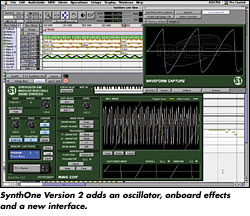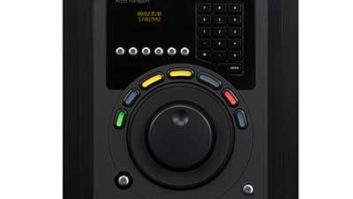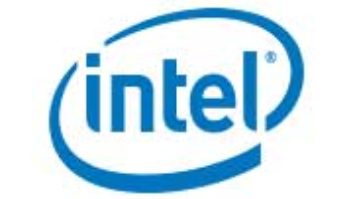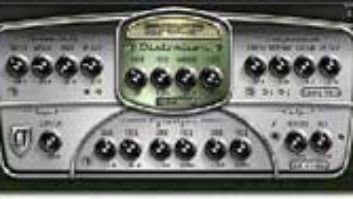
There are plenty of native virtual instruments in a rainbow offormats, but the development of software instruments for TDM has beenlargely neglected. Recently, a handful of TDM-based instruments havecropped up. One such instrument is McDSP’s two-oscillator wavetablesynth, Synthesizer One (or SynthOne for short).
Version 1 of SynthOne debuted in March 2002. The latest release, V.2, takes the instrument up several notches. Several significant bugfixes and major enhancements were made, including a thirdanalog-modeling oscillator, an entirely reworked user interface andonboard effects. (Version 2.01 was about to be released as I put thefinishing touches on this field test. It adds OS X support, faster loadtimes and a more integrated Performance Generator, among otherimprovements.)
SHINY NEW GUI
SynthOne requires a Pro Tools Mix or HD system. With V. 2, you canget up to eight voices on a MIX SRAM chip or 10 voices on any HD chip(because they are all SRAM). Different versions of the plug-in areavailable from your plug-in menu: mono or stereo; and four, six oreight-voice. However, you are limited to two instances per chip on aMix system. The paradigm is a little different with HD: A pool of eightvoices is shared when there is more than one instantiation on a chip.SynthOne is not multitimbral, though this is not a big problem becauseyou can always open another instance, assuming that you have theavailable DSP power.
Copy protection is via standard challenge/response or iLok USBdongle. Authorization can be installed on the iLok either by licensecard or directly through your personal account at the iLok Website.
The plug-in’s new user interface is much easier on the eyes: Theknobs have been redesigned and there are no more yellow parameterlabels. Losing V. 1’s green and yellow color scheme is a welcomechange.
PARAMETER HAPPY
SynthOne comprises eight different pages; a handy area on the mainpage’s left side is reserved for quick access to its most basicparameters. Examples of Quick Page parameters include clock source,bender range, glide time, filter freq and ADSR. It would be nice to seea Quick Page for the new effects, too. But despite this omission, itreally streamlines searching for rudimentary parameters. Users who areuninterested in serious programming and just want to fine-tune a presetwill appreciate this feature.
Wavetable oscillators 1 and 2 and analog-modeling oscillator 3,along with controls for mixing and filtering these sources, are foundon SynthOne’s first page: the OSC Page. There are numerous waveforms tochoose from — sines, squares, triangles, saw up/down — andyou can capture your own wavetable using the included Synthesizer OneWave-Capture Audio Suite plug-in. Oscillator 3 tracks the pitch ofoscillator 1 and can be detuned two octaves down. An external audiosource (from the aux or audio track where the plug-in is inserted) canbe mixed with the oscillators for some really cool effectsprocessing.
There are three LFOs on the LFO page; each LFO’s shape is created bycombining two waveforms: waves 1 and 2. The same shapes available forthe oscillators are available to the LFOs. When you combine twowaveforms, the resulting shape is drawn next to the LFO — a nicetouch. There are attack and release parameters for each LFO, but LFOdelay is missing. The envelopes can be assigned to a variety ofmodulation targets throughout the plug-in’s pages (like in the ModMatrix section of the System page). All of the LFOs can be synchronizedto each other or an external MIDI Beat Clock.
Two VCFs (virtually controlled filters, rather thanvoltage-controlled filters because they are virtual) and two assignableVCAs make up the Filter and Envelope page. Both VCFs are two-pole, 12dB/octave with a choice of either low, high and bandpass, or band stopfilter types. Filters can be used in serial, parallel and modularrouting. Both VCAs are ADSTAR (attack, decay, sustain time, attack onkey release and release) for serious envelope control.
The Wave Edit page is where you create your own wavetables. Up toeight custom wavetables can be stored with a preset and then recalledvia the OSC and LFO waveform shape pop-up menus. You can use a varietyof algorithms to generate and customize your waveshape, capture yourown shape (up to 256 samples) with the Wave Capture plug-in, or simplydraw one freehand. The ability to capture your own wavetable is anamazingly powerful feature that adds new dimensions of depth andrealism to your sounds.
All 128 MIDI controller numbers can be assigned to any of SynthOne’snearly 300 parameters. The assignment menus are spread out over twopages: 0 to 63 and 64 to 127. Being able to assign any of Synth-One’sparameters to a MIDI controller number is wonderfully empowering.However, the pop-up menus used to select the instrument’s parametersare too long and not alphabetically organized, which makes finding theparameter you want to assign difficult. I’m sure that there is a betterway to organize these menus. Note that new MIDI controller assignmentsaren’t remembered until you save your preset; this is a bug that McDSPsays will be fixed shortly.
Global functions (like note-stealing protocols, number of unisonvoices and velocity response), effects, modulation sources andMIDI-performance controllers are found on the System page. Again, anyof SynthOne’s nearly 300 para-meters can be assigned, two at a time, tothe performance control sources. The Mod Matrix contains fourassignable sources and targets, with an amount of modulation controlfor each pairing. The Effects section is a basic delay: rate, depth,delay, feedback and mix. Nothing too special, but it works well tothicken up presets. Delays can be locked to incoming MIDI Beat Clock atstandard note values. And, if you just need a touch of EQ to perfect apreset, a stereo EQ is selectable between highpass, low or highshelf.
The plug-in’s final page is dedicated to a unique PerformanceGenerator. More than an arpeggiator, you can sequence custom patternsof up to 16 events. Each event can have its own interval (relative tothe Performance Generator mode), velocity and duration (in standardnote values). You can create your own pattern or choose from a preset;patterns can be locked to an external MIDI Beat Clock. PatternGenerator is a lot of fun: Write crazy arpeggiation sequences or use itto automatically generate bass or lead lines to your chords. (Version2.01 allows the Performance Generator to continue playing even when theplug-in’s window is closed.)
ONE SYNTH TO PLAY
When I first tried SynthOne, I was not impressed by its soundquality: I found it rather thin and boring. But I soon realized thatthis was not the instrument’s problem, but instead the fault of wimpypresets. Though SynthOne has some great-sounding presets, the contentsof the first folders I visited were lackluster. SynthOne needs a rootfolder that’s packed with presets that sell the instrument and createthe “Wow, I’ve got to have this!” response. For example, P5Pad 3 is a big sweeping pad that sounds wonderful. It’s in the Prophet5 folder, inside the Sampled Wave folder in the Presets folder. Andthere are several fat-sounding bass patches in the Bass Sounds folder,which is in the JW Presets folder inside the Presets folder.
But despite SynthOne’s poor preset planning, V. 2 does offer a newand unique patch-organization feature called Virtual Cartridge, whichstores up to 64 patches that can be accessed via MIDI patch changes. Ilove the ability to automate patch changes and flip through presetsusing increment/decrement keys on my control keyboard — the onlyproblem with Virtual Cartridges. I hope this is fixed soon.
Version 2 is a big improvement over V. 1, not just in features butin overall sound quality. I did not find that SynthOne’s limitedpolyphony and lack of multitimbral operation were problems. The typesof sounds that it excels at — vintage synth pads, bass and leadssounds — don’t generally require many voices. If you’re lookingfor a new TDM synth to add to your sound module arsenal, then SynthOneis definitely worth a listen, especially if tweaking parameters,capturing your own wavetables, lots of MIDI control and solid vintagesynth emulation excite you. And to close the deal, its retail price hasbeen lowered from $695 to $495.
McDSP, 650/320-8452, www.mcdsp.com.
Visit Erik Hawkins’ indie label atwww.muzicali.com.



